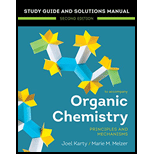
Concept explainers
(a)
Interpretation:
The structural formula of hexyl alcohol is to be drawn. The primary alcohol, secondary alcohol, or tertiary alcohol is to be identified.
Concept introduction:
Trivial names of some alcohols are still in common use. They are derived from the trivial names of the
Depending on the type of carbon – primary, secondary, or tertiary – to which the hydroxyl group is attached, the alcohol is classified as a primary, secondary, or tertiary alcohol.
(b)
Interpretation:
The structural formula of neopentyl alcohol is to be drawn. The primary alcohol, secondary alcohol, or tertiary alcohol is to be identified.
Concept introduction:
Trivial names of some alcohols are still in common use. They are derived from the trivial names of the alkane to which the hydroxyl group is attached. The first part of the name is derived from the trivial name of the root alkane. The second part is simply alcohol, indicating the functional group.
Depending on the type of carbon – primary, secondary, or tertiary – to which the hydroxyl group is attached, the alcohol is classified as a primary, secondary, or tertiary alcohol.
(c)
Interpretation:
The structural formula of pentafluoroethyl alcohol is to be drawn. The primary alcohol, secondary alcohol, or tertiary alcohol is to be identified.
Concept introduction:
Trivial names of some alcohols are still in common use. They are derived from the trivial names of the alkane to which the hydroxyl group is attached. The first part of the name is derived from the trivial name of the root alkane. The second part is simply alcohol, indicating the functional group.
Depending on the type of carbon – primary, secondary, or tertiary – to which the hydroxyl group is attached, the alcohol is classified as a primary, secondary, or tertiary alcohol.
(d)
Interpretation:
The structural formula of cyclohexyl alcohol is to be drawn. The primary alcohol, secondary alcohol, or tertiary alcohol is to be identified.
Concept introduction:
Trivial names of some alcohols are still in common use. They are derived from the trivial names of the alkane to which the hydroxyl group is attached. The first part of the name is derived from the trivial name of the root alkane. The second part is simply alcohol, indicating the functional group.
Depending on the type of carbon – primary, secondary, or tertiary – to which the hydroxyl group is attached, the alcohol is classified as a primary, secondary, or tertiary alcohol.
Want to see the full answer?
Check out a sample textbook solution
Chapter E Solutions
EBK ORGANIC CHEMISTRY: PRINCIPLES AND M
- Curved arrows are used to illustrate the flow of electrons. Using the provided starting and product structures, draw the curved electrons-pushing arrows for the following reaction or mechanistic step(s).arrow_forwardWhat is the IUPAC name of the following compound? CH₂CH₂ H CI H₂CH₂C H CH₂ Selected Answer: O (35,4R)-4 chloro-3-ethylpentane Correctarrow_forwardCurved arrows are used to illustrate the flow of electrons. Using the provided starting and product structures, draw the curved electrons-pushing arrows for the following reaction or mechanistic step(s).arrow_forward
- Curved arrows are used to illustrate the flow of electrons. Using the provided starting and product structures, draw the curved electron-pushing arrows for the following reaction or mechanistic step(s). Be sure to account for all bond-breaking and bond-making steps. I I I H Select to Add Arrows HCI, CH3CH2OHarrow_forwardCurved arrows are used to illustrate the flow of electrons. Use the reaction conditions provided and the follow the arrows to draw the intermediate and product in this reaction or mechanistic step(s).arrow_forwardCurved arrows are used to illustrate the flow of electrons. Use the reaction conditions provided and follow the curved arrows to draw the intermediates and product of the following reaction or mechanistic step(s).arrow_forward
- Curved arrows are used to illustrate the flow of electrons. Use the reaction conditions provided and follow the arrows to draw the intermediate and the product in this reaction or mechanistic step(s).arrow_forwardLook at the following pairs of structures carefully to identify them as representing a) completely different compounds, b) compounds that are structural isomers of each other, c) compounds that are geometric isomers of each other, d) conformers of the same compound (part of structure rotated around a single bond) or e) the same structure.arrow_forwardGiven 10.0 g of NaOH, what volume of a 0.100 M solution of H2SO4 would be required to exactly react all the NaOH?arrow_forward
- 3.50 g of Li are combined with 3.50 g of N2. What is the maximum mass of Li3N that can be produced? 6 Li + N2 ---> 2 Li3Narrow_forward3.50 g of Li are combined with 3.50 g of N2. What is the maximum mass of Li3N that can be produced? 6 Li + N2 ---> 2 Li3Narrow_forwardConcentration Trial1 Concentration of iodide solution (mA) 255.8 Concentration of thiosulfate solution (mM) 47.0 Concentration of hydrogen peroxide solution (mM) 110.1 Temperature of iodide solution ('C) 25.0 Volume of iodide solution (1) used (mL) 10.0 Volume of thiosulfate solution (5:03) used (mL) Volume of DI water used (mL) Volume of hydrogen peroxide solution (H₂O₂) used (mL) 1.0 2.5 7.5 Time (s) 16.9 Dark blue Observations Initial concentration of iodide in reaction (mA) Initial concentration of thiosulfate in reaction (mA) Initial concentration of hydrogen peroxide in reaction (mA) Initial Rate (mA's)arrow_forward
 Chemistry: Matter and ChangeChemistryISBN:9780078746376Author:Dinah Zike, Laurel Dingrando, Nicholas Hainen, Cheryl WistromPublisher:Glencoe/McGraw-Hill School Pub Co
Chemistry: Matter and ChangeChemistryISBN:9780078746376Author:Dinah Zike, Laurel Dingrando, Nicholas Hainen, Cheryl WistromPublisher:Glencoe/McGraw-Hill School Pub Co Introductory Chemistry: An Active Learning Approa...ChemistryISBN:9781305079250Author:Mark S. Cracolice, Ed PetersPublisher:Cengage Learning
Introductory Chemistry: An Active Learning Approa...ChemistryISBN:9781305079250Author:Mark S. Cracolice, Ed PetersPublisher:Cengage Learning Chemistry: The Molecular ScienceChemistryISBN:9781285199047Author:John W. Moore, Conrad L. StanitskiPublisher:Cengage Learning
Chemistry: The Molecular ScienceChemistryISBN:9781285199047Author:John W. Moore, Conrad L. StanitskiPublisher:Cengage Learning ChemistryChemistryISBN:9781305957404Author:Steven S. Zumdahl, Susan A. Zumdahl, Donald J. DeCostePublisher:Cengage Learning
ChemistryChemistryISBN:9781305957404Author:Steven S. Zumdahl, Susan A. Zumdahl, Donald J. DeCostePublisher:Cengage Learning Chemistry: An Atoms First ApproachChemistryISBN:9781305079243Author:Steven S. Zumdahl, Susan A. ZumdahlPublisher:Cengage Learning
Chemistry: An Atoms First ApproachChemistryISBN:9781305079243Author:Steven S. Zumdahl, Susan A. ZumdahlPublisher:Cengage Learning





